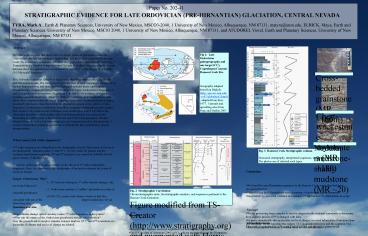STRATIGRAPHIC EVIDENCE FOR LATE ORDOVICIAN PREHIRNANTIAN GLACIATION, CENTRAL NEVADA - PowerPoint PPT Presentation
1 / 1
Title:
STRATIGRAPHIC EVIDENCE FOR LATE ORDOVICIAN PREHIRNANTIAN GLACIATION, CENTRAL NEVADA
Description:
... 3rd-order sequences (30-100 m thick) were identified between the Chatfieldian ... Does climate change (glacio-eustasy) cause 3rd order sequences in deep time? ... – PowerPoint PPT presentation
Number of Views:70
Avg rating:3.0/5.0
Title: STRATIGRAPHIC EVIDENCE FOR LATE ORDOVICIAN PREHIRNANTIAN GLACIATION, CENTRAL NEVADA
1
Paper No. 202-41
STRATIGRAPHIC EVIDENCE FOR LATE ORDOVICIAN
(PRE-HIRNANTIAN) GLACIATION, CENTRAL NEVADA
TYRA, Mark A., Earth Planetary Sciences,
University of New Mexico, MSCO3-2040, 1
University of New Mexico, Albuquerque, NM 87131,
matyra_at_unm.edu, ELRICK, Maya, Earth and Planetary
Sciences, University of New Mexico, MSC03 2040, 1
University of New Mexico, Albuquerque, NM 87131,
and ATUDOREI, Viorel, Earth and Planetary
Sciences, University of New Mexico, Albuquerque,
NM 87131
Abstract Previous work suggests that there were
two major pulses of glaciation in the Late
Ordovicianthe late Mohawkian (Chatfieldian) and
the well-documented Hirnantian event. We examined
a composite section of the Upper Ordovician
Hanson Creek (OHC) Formation in the Monitor Range
in central Nevada to evaluate the paleoclimatic
history between these two glacial intervals and
identify and interpret the origins of 3rd-order
(1-5 My-scale) sequences. Five 3rd-order
sequences (30-100 m thick) were identified
between the Chatfieldian and Hirnantian events.
The transgressive systems tract of each sequence
is composed of basinal lime mudstone and shale
and the highstand systems tracts, and sequence
boundaries are composed of progressively
shallower water wackestones (Sequences 1 and 2)
to packestone-grainstones (Sequences 3, 4, and
5). No evidence of sequence boundary
unconformities was observed. With cross-bedded
skeletal grainstones and debris flow
conglomerates, the top of Sequence 3 possesses a
sedimentological imprint essentially identical to
that observed at the Hirnantian glacial event,
which overlies Sequence 5. Preliminary
conclusions from these sequence stratigraphic
trends suggest that extensive My-scale sea-level
changes were occurring at least 8 My before the
Hirnantian glaciation, which implies that
Gondwanan glaciers were present and fluctuating
in volume prior to the well known end-Ordovician
glaciation. Samples obtained from these five
3rd-order sequences are being processed to
determine the O-isotope composition of apatitic
conodonts to substantiate these preliminary
glacial interpretations.
Fig 1 Late Ordovician paleogeography and our
target (CC), Copenhagen Canyons Hanson Creek
Fm. Geography adapted from Ron Blakely
(http//jan.ucc.nau.edu/rcb7/globaltext2.html),
adapted from Ross 1977. Currents and upwelling
sites from Pope and Steffen 2003
Cross-bedded grainstone (MR 160m)
Chert-wackestone rhythmites (MR 180)
- What causes 3rd order sequences?
- 3rd order sequences are ubiquitous in the
stratigraphic record. Their cause, however, is
not understood. Tectonics cause 1st and 2nd (gt10
Myr) order SL change and the resultant
depositional sequences. 4th and 5th sequences are
caused by orbitally forced glacio-eustasy
(Milankovitch). - Cenozoic studies point to glacio-eustasy as the
driver of 3rd order sedimentary sequences. Here,
we characterize the stratigraphy of an area to
estimate the extent of sea-level change. - Target Ordovician. Why?
- 1. If Cenozoic undergoes 3rd order climatic
change, why not in the Paleozoic? - 2. Ordovician contains a sudden glaciation in
a time of extended greenhouse - (8-10x CO2, warm water fauna extensive) that
also coincided with one of the largest
extinctions--its an interesting time.
Nodular mudstone-shaley mudstone (MR 20)
Fig. 3 Hanson Creek Stratigraphic
column Measured stratigraphy, interpreted
sequences, and relative sea level. The photos
are of selected rock types.
- Conclusions
- We found five pre-Hirnantian sequences in the
Hanson Creek, more than had been recognized
before - Extensive sea level fluctuations were occurring
--Gondwanan icecap dynamics? - Interpreted OHC sea level variation in sequence
C3 approaches C6 (Hirnantian) in scope - Next up?
- We are processing large samples to recover
diagenetically resistant conodonts to determine
how climatic proxies (d18O) changed with time. - To prove climatically-driven eustatic sea level
change, we need information from more than one
location. We are targeting the eastern US
Cincinnati Arch next, and the southern NM Montoya
group and Estonian Livonian basin are also
possibilities
Fig. 2 Stratigraphic Correlation Chronostratigrap
hic units, biostratigraphic markers, and
sequences pertinent to the Hanson Creek
formation. Figure modified from TS-Creator
(http//www.stratigraphy.org) and augmented with
Harris et al (1995), Holland and Patzkowsky
(1996), Pope and Read (1997), and Saltzman (2005).
- Questions and Aim
- Does climate change (glacio-eustasy) cause 3rd
order sequences in deep time? - What was the nature of the Ordovician
greenhouse-to-icehouse transition? - Lay the groundwork to employ climatic isotopic
markers (d13C and d18Oconodonts) to determine if
climate and sea level change are related.
- Remarks
- Generally five eustatic sea level sequences are
noted in the Cincinnatian - The d13Cwr data of Saltzman (2005) of OHC shows
an anomaly near the Hirnantian (during C5 and
C6). Otherwise, the curve is unremarkable.
Acknowledgements This work is supported by NSF
grant EAR-0518205 and also GSA grants in aid.































